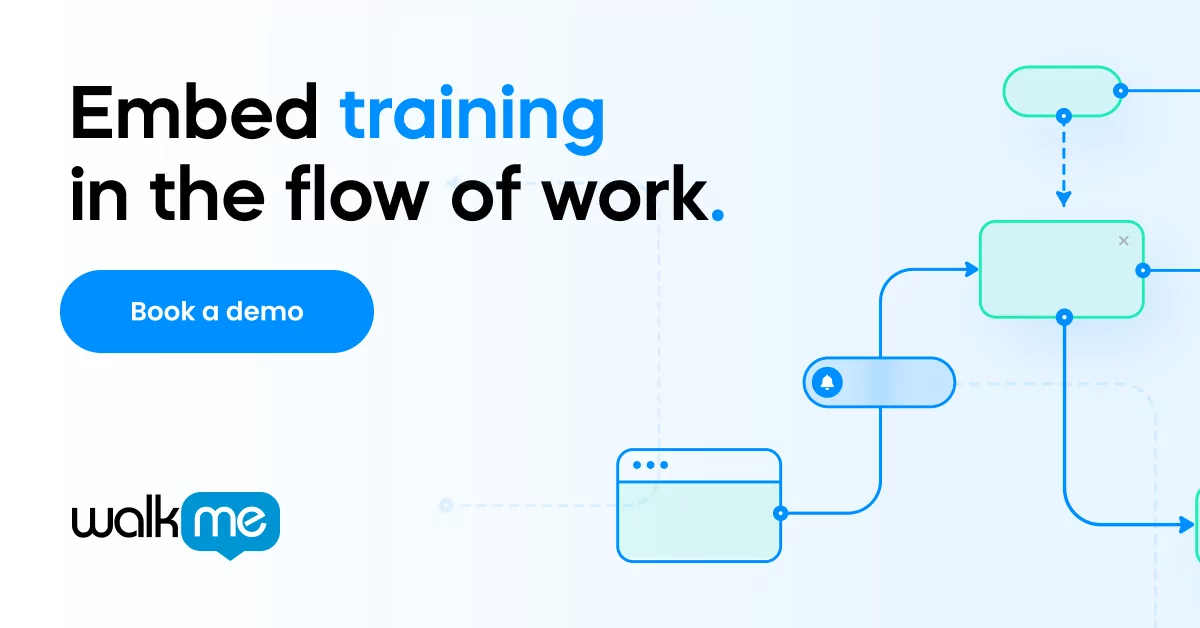In a time where organizations have to do more with less, cross-training should be a priority. The ability to strengthen and expand an employee’s skill set allows companies to be leaner in these uncertain financial times and help them mitigate talent gaps.
What is cross-training?
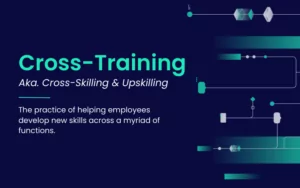
Cross-training is the practice of helping employees develop new skills across a myriad of functions. This process both empowers employees with the skills that are needed within the organization, as well as ensures that the company has the talent necessary to meet their goals for growth and expansion.
Why is cross-training important now?
While cross-training has always been a necessity, current fears of a recession and economic turmoil have made it imperative. As companies are forced to make do with a leaner workforce, employee cross-training has moved to the forefront.
Cross-training can be a practical solution during difficult times, but it should never be an afterthought. Corporations must prioritize investing in promoting and developing their people. Employee development should be an organizational focus to build a stronger foundation.
In the end, cross-training is a mutually beneficial process that creates a stronger workforce while providing employees with growth opportunities, preventing them from feeling stagnant in their jobs. While the current downturn has highlighted the importance of cross-training, it should now become a major focus for most organizations going forward.
How to identify candidates for cross-training
One has to remember that economic hardship brings with it both challenges and opportunities for employees. Employees and organizations are both given an opportunity to prove themselves.
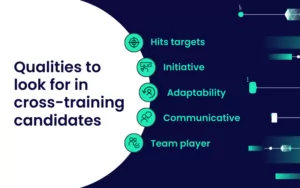
In order to identify suitable candidates for cross-training, it’s important to monitor employee engagement using a combination of tech tools and management. Seek out employees who consistently achieve their goals and show initiative and adaptability, as well as possess strong communication, teamwork skills, and possible hidden talents. By taking a thoughtful and comprehensive approach to selecting employees for cross-training, organizations can cultivate a versatile and skilled workforce.
What are the benefits of cross-training employees?
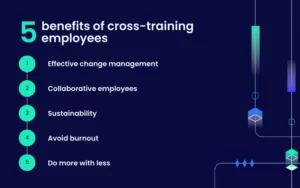
- A more effective approach to change management
Remaining agile and competitive in any business environment requires organizations to prioritize adaptability. In order to embrace changes, such as process changes or regulatory and data changes, cross training is vitally important.
Now, combine those changes with downscaling of the workforce, and cross-skilling becomes essential. Employees are being asked to take on additional roles that require not only skills that they already possess but new and specific skill sets that must be learnt quickly. When successful, cross-training leads to a pared down, but incredibly productive workforce ready for any change. - Produce more collaborative employees
In the past, many companies functioned in a silo system, which created an environment where one only communicated and collaborated with those within their shared silo. This inhibits collaboration and creativity, fosters a resistance to change, and prevents employees from working towards shared goals.
With the rise of digital transformation and the incorporation of chief digital officers, companies are breaking down barriers of cross collaboration. Everyone has to know about the other spokes in the organizational wheel and what they do in order to create an efficient working chain. In other words, it is not about how one person does their job, but rather, how everyone works together that brings greater value to the organization. - Sustainability
To achieve sustainability, organizations need to have a clear vision and embrace cross-sector training and technologies. Cross-training is crucial, as it enables employees to gain knowledge about different aspects and workflows of the organization, breaking down organizational divides and improving efficiency.
Providing a deeper understanding of departmental and organizational vision helps limit miscommunication and duplicative tasks, allowing employees to fill in for coworkers outside of their silo. This leads to increased job satisfaction and performance in the long run, reducing turnover and fostering loyalty. Ultimately, this approach contributes to the sustainability of the workforce as well as the organization as a whole.
- Avoid burnout of top players & managers
When it comes to the workforce, it is always important to think long term. You will always find those employees willing to step up. Organizations also have greater expectations from more senior workers and those in managerial positions who possess a variety of skills.
In leaner times, these employees might have to take on additional or combined roles – even roles they have moved on from and those of former subordinates, dependent on company needs. The key is not to over utilize, over stack, and work people to death. Furthermore, there are always roles that require specific certification or education that must be maintained.
Implementing cross-training programs for employees fosters a collaborative work environment in which all team members can contribute and alleviate each other’s workload. This not only enables top performers to manage their workload more effectively but also helps prevent burnout across the entire organization. - Do more with less
Cross-training employees can help organizations be more productive and efficient by improving staffing flexibility and reducing downtime. It provides employees with opportunities for growth – making them more versatile and capable of performing tasks outside the scope of their job. Cross-trained employees allow organizations to maintain a steady workflow, even when staffing levels have been cut, and reduces the need for external hires or temporary staff.
How to develop a cross-training program strategy
Technology is the key to an efficient cross-training strategy. That said, it is imperative that the technology is user friendly so that employees can readily achieve their goals and become effective members of the team in a timely fashion.
We no longer live in a world where new hires necessarily come into a job with the required skills to start work on day one, or where manpower is available to train each employee.
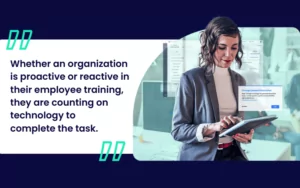
Whether an organization is proactive or reactive in their employee training, they are counting on technology to complete the task. This means that their software must be easily adoptable and up to the role of accelerating productivity from the get go.
How can a Digital Adoption Platform help with cross-training programs & strategy
Digital adoption enables organizations to fully utilize their technology, and it is WalkMe’s bread and butter. Our Digital Adoption Platform (DAP) is a software overlay that helps employees learn how to use web-based, desktop and mobile apps easily. We have simplified the user experience so that employees can comfortably adapt to new and changing technologies. But cross-training employees is not just about learning how to use technologies; it’s about how to use them to become a better and smarter employee.
What is special about WalkMe’s system is that it not only effortlessly guides the user in learning new technologies, but equally as important, it also assists them in their decision making, thereby creating a smarter employee. We are not just enabling new technologies, we are actually enabling business processes.
Even prior to the current economic downturn, WalkMe boasted of the ability to help companies improve employee productivity and efficiency. Now, especially, as companies are forced to shed employees, our clients are able to do more with less. WalkMe empowers the employee to become more proficient and productive.
What are the challenges of cross-training employees?
Cross-training programs can be incredibly important and positive for an organization. For example, it helps to fill in gaps during absences thereby mitigating interruptions, it provides for flexibility, and it can motivate employees to be more productive. But, like with any corporate change, initiating cross-training can create challenges.
Oftentimes cross-training can make employees uncomfortable and question their importance to the organization. They view others’ learning skills as a threat. As well, employees who take the time and make an effort to acquire new skills feel that they should be rewarded either monetarily or by advancement. Companies must figure these scenarios into their corporate strategies or they risk losing valuable employees, possibly even incurring a great resignation. A company has to keep morale in mind.
Cross-training and alternative employee training can be expensive and it is not a one time deal.
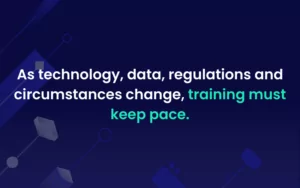
As technology, data, regulations and circumstances change, training must keep pace. With all the challenges presented by cross-training, it is vital to the long term sustainability of an organization, and the WalkMe DAP can ensure that it is done correctly.
How DAPs can cross-train employees faster
Over the past three years companies have had to adapt to incredibly challenging times. While the pandemic may be abating, world events and an economic downturn have further complicated the workplace and necessitated important workforce changes, one of which is downsizing. Companies have been forced to do more with less and this has called for an acceleration of cross-training at a very quick pace. Organizations have let go entire departments in some cases, forcing others to take on roles they do not necessarily have the skills needed for.
Why opt for WalkMe for developing a cross-training program?
DAPs are one of the fastest ways to cross-train effectively. The traditional way of training employees is both time consuming and requires staff. Digital adoption helps companies mitigate training challenges by empowering the employee through on-demand training, personalization, and the program’s ability to realize struggles and the user’s learning curve. WalkMe is the only enterprise-ready DAP solution designed for scale with built-in agility, WalkMe provides its customers with the tools they need to accelerate their digital transformation efforts. Furthermore, with over 40% market share, we are the most established DAP vendor in the industry.
Additionally, WalkMe’s partner ecosystem offers a range of tips and best practices to enhance your software ROI. We provide comprehensive training and certification in digital adoption practices, ensuring that you implement the digital adoption strategy that best suits your enterprise’s needs, such as developing cross-training programs.
